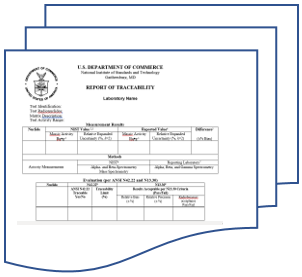Summary
The performance of individual labs for specific measurements is determined by the use of a proficiency test. Results reported by labs are compared to a reference value for the given sample (measurand) and the laboratory’s performance is evaluated to aid in performance improvement. NIST Radiochemistry Intercomparison Program (NRIP) is a proficiency-testing program that evaluates the capabilities of laboratories to measure low-levels of radionuclides in environmental and simulated bioassay samples. The program is open to any organization/lab worldwide.
Description

The NRIP includes five matrices (acidified water, air filters, soil, synthetic urine and synthetic feces) of test samples spiked with a well-characterized solution that contains alpha-, beta-, and gamma-emitting radionuclides (see Table 1). The NRIP participants decide which radionuclides they will analyze and which measurement results they will report to NIST.
Two modes of traceability evaluation exercises are provided: a) an emergency preparedness exercise with an 8-hour reporting time, and b) a customary exercise with a 60-day reporting time.
A set of samples consists of five intercomparison samples– five replicate samples for the 60-day turnaround program, five samples across a range of concentrations for the 8-hour turnaround program– and 3 – 5 blank samples. Each participating laboratory receives the number of test sample distributions specified in their agreement with NIST.
The laboratory’s analytical results are to be reported to NIST within 8 hours (emergency preparedness exercise) or 60 days (customary exercise) after the participating laboratory informs NIST that it has begun analysis of a sample set. The laboratory reports a result for each measurement and a relative expanded uncertainty (k=2) for each measurement. For the customary (60-day turnaround) exercise, the mean value of replicate results together with the relative expanded uncertainty (k=2) of the mean value is also reported.
Upon completion of each test, NIST analyzes the results and issues a Report of Traceability, 45 days after the reporting date for the measurement, which includes the reported values and the NIST values and their relative expanded uncertainties (k=2), and the relative bias. An evaluation of traceability and traceability limits per the ANSI N42.22 standard, and when appropriate, evaluation of radiobioassay measurement bias and precision per ANSI/HPS N13.30-2011, is done for the customary (60-day turnaround) exercise.
Table 1. Radionuclides and their maximum activities considered for NRIP
|
Potential Certified Nuclides |
Maximum Bq/Sample |
Maximum Bq/Sample |
|---|---|---|
|
Mn-54 |
250 |
250 |
|
Co-57 |
250 |
250 |
|
Co-58 |
250 |
250 |
|
Co-60 |
250 |
250 |
|
Zn-65 |
250 |
250 |
|
Sr-89 |
1 |
10 |
|
Sr-90 |
4 |
10 |
|
Ba-133 |
250 |
250 |
|
Cs-134 |
250 |
250 |
|
Cs-137 |
250 |
250 |
|
Eu-152 |
250 |
250 |
|
Ir-192 |
250 |
250 |
|
Pb/Po-210 |
1 |
10 |
|
Ra-226 |
1 |
10 |
|
Ra-228 |
1 |
10 |
|
Th-228 |
2 |
20 |
|
Th-230 |
2 |
20 |
|
Th-232 |
2 |
20 |
|
U-234 |
1 |
10 |
|
U-235 |
1 |
10 |
|
U-238 |
1 |
10 |
|
Np-237 |
1 |
10 |
|
Pu-238 |
1 |
10 |
|
Pu-239 |
1 |
10 |
|
Pu-240 |
1 |
10 |
|
Am-241 |
1 |
10 |
|
Cm-243 |
1 |
10 |
|
Cm-244 |
1 |
10 |

